Hello again!
It's a very busy time at Pine Hill with school holidays and the Berragoon Production Sale coming up this weekend, and now we are planning our first Regenerative Equine Property workshops! This is very exciting as we are finally able to offer our acquired knowledge and experience to more people. I have put up a link and poster on our website, so check it out if you're interested.
The rehabilitated creek area is now pretty finished and it has really taken off! Full of literally dozens of different grasses, herbs, shrubs, trees and packed with birds and wildlife, it is a very important part of the farm already. It is clear that this area is going to be a literal seed bank for native grasses throughout the property and the water coming down the creek is beautiful.
 |
| Kangaroo Grass in the foreground, the creek gorge behind |
 |
| Strong growth! |
 |
| Waist high grasses |
This photograph on the left shows an area of ground that had been heavily infested with Capeweed a couple of months ago. Capeweed hates hot temperatures and always dies off by late spring, leaving bare patches of earth - the most problematic part! You can see native grasses encroaching on this area, thought, and the mulch left from the dead Capeweed is very useful in providing nutrients for the soil microbiome.
There is no need to spray Capeweed if it is not completely dominating your pasture - it will die off in due course.
I will post another section after the Berragoon Sale (8-10 January - check out Elite Livestock Auctions for the auction info!) focusing on the eroded 'pond' we have worked hard to re-vegetate and rehabilitate. It's quite a changed area!



